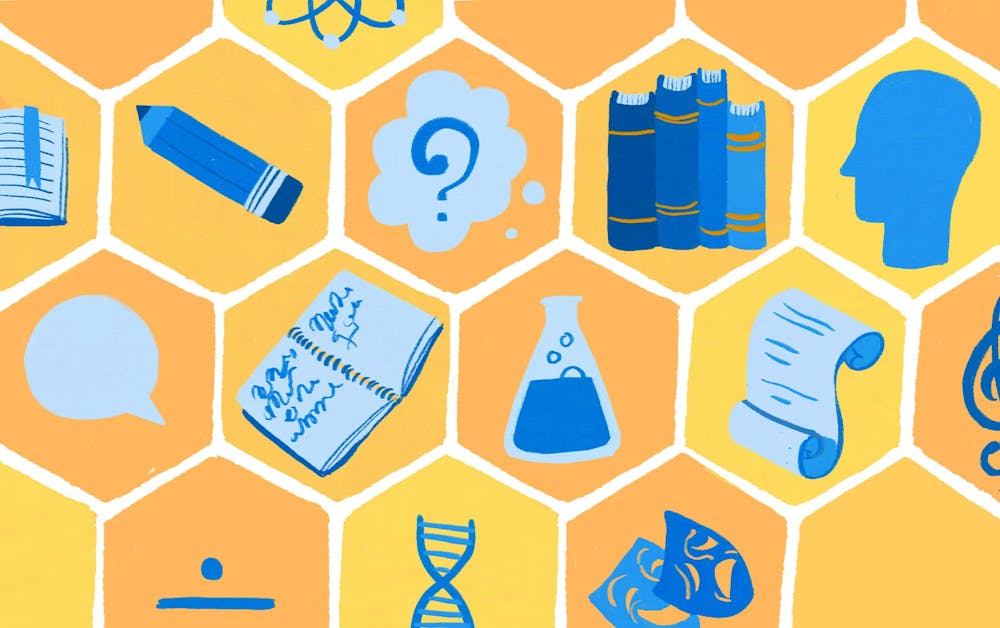Whether students are unsure of their future career or are determined to work in law, business, service or anything in between, they all have at least one thing in common — these students can benefit from pursuing a degree in the arts and sciences.
As our world progresses and jobs become less defined, the demands of the workforce require people to be adaptive, innovative and to take interdisciplinary perspectives to solve problems.
Those with an education in the arts and sciences — commonly referred to as "liberal arts" — historically have helped shape the world's knowledge and workforce by promoting key ideals.
During its conception in the classical era, liberal arts consisted of only three subjects: grammar, rhetoric and logic. The medieval era followed, adding four more subjects: arithmetic, geometry, music and astronomy.
It was considered by some to be an "essential education for a free individual active in civic life."
Fast forward to centuries of additional knowledge, and now, liberal arts is currently divided into four disciplines: humanities, social sciences, natural sciences and formal sciences, with numerous sub-disciplines within each field.
Paul LePore, associate dean for Student and Academic Programs in The College of Liberal Arts and Sciences, said that one of the things an arts and sciences degree does, both historically and currently, is provide students with a set of skills to be successful in many different career areas.
The ability to think critically about complicated issues, write and communicate effectively across a variety of settings, and develop cultural literacy and global connectedness are all indicative of the many desirable skills advanced through the study of the arts and sciences.
What makes an educated person, according to LePore, is a specialization in one or more majors, in addition to the ability to take classes in languages, history, science, social science, engineering and arts.
"An educated person has all of those opportunities, and I think an arts and sciences degree does that very well," said LePore.
Even if students are unsure of what the future has in store for them, an arts and sciences curriculum will provide them with the flexibility to determine their passions.
Critics of degrees in the arts and sciences argue that these programs do not provide a significant depth of experience or study in one area and that opportunities to gain proficiency in technical skills are lacking due to its interdisciplinary nature.
However, LePore believes the interdisciplinary aspect of a liberal arts and sciences degree gives those graduates an advantage in their future career endeavors.
"Some of the big questions of the day don’t have simple solutions and they really require perspectives from lots of different lenses," said LePore. "So, one of the hallmarks of an arts and sciences education is that you get to unpack a knotty problem from a lot of different vantage points."
Although liberal arts and sciences graduates are known for making a smaller starting salary than STEM graduates — who pride themselves on their technical skills — having an overly specialized technical background in a world where technology is constantly evolving is detrimental to earning outcomes further in their careers.
This is because these skills are more prone to becoming automated, possibly rendering those career paths obsolete.
An arts and sciences education armors graduates with the breadth and depth of timeless skills applicable to all careers — namely, the capability to analyze problems critically, manage resources effectively and think globally.
"There isn’t a week that goes by that I don’t meet with an employer who talks specifically about the arts and sciences as being the type of student that they want," said LePore.
With over 25,000 students currently enrolled and 1,200 faculty, The College is the largest school at ASU, consisting of over 95 undergraduate majors from 23 academic units.
With over 25,000 students currently enrolled and 1,200 faculty, The College is the largest school at ASU, consisting of over 95 undergraduate majors from 23 academic units, and is developing new ways to prepare students for their futures.
"One of the things we started when we moved to Armstrong Hall is we developed what’s called the Futures Center," said LePore.
The Futures Center, in partnership with Career and Professional Development Services, integrates career readiness from the moment students arrive at ASU.
Through internships, research opportunities and study abroad experiences, The College provides a network of resources to help students attain their short-term and long-term goals.
"We would have looked for models of other arts and sciences colleges if there were some to the degree that we're doing," said LePore. "I think we might be leading it now."
Reach the columnist at eggold@asu.edu or follow @EGG0LD on Twitter.
Editor’s note: The opinions presented in this column are the author’s and do not imply any endorsement from The State Press or its editors.
Want to join the conversation? Send an email to opiniondesk.statepress@gmail.com. Keep letters under 500 words and be sure to include your university affiliation. Anonymity will not be granted.
Like The State Press on Facebook and follow @statepress on Twitter.




